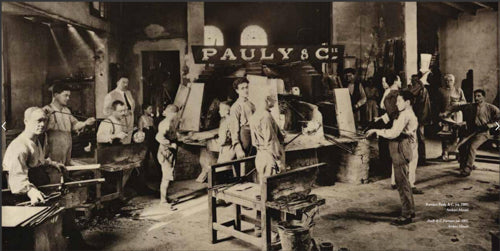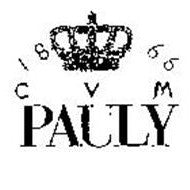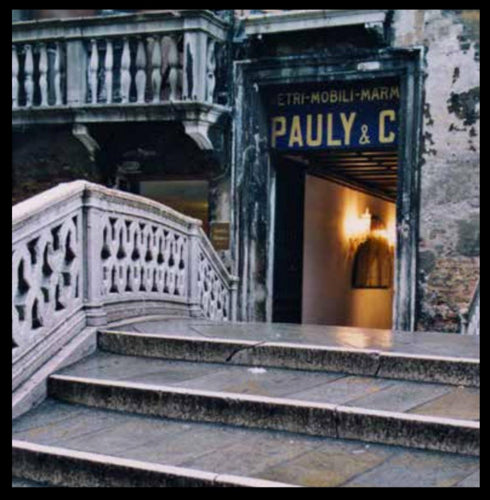We often get contacted for news of this glorious ateler.
Unfortunately the company after being renamed Miva Srl went bankrupt on 26 April 2016.
Since its foundation (1866), Pauly & C. has stood for elegance, creativity and Venetian luxury.
The ancient Roman technique known as “murrine”, which today is the symbol of Murano glass, was reproduced for the first time in its workshops and was presented to the world at the Universal Exhibition in Paris in 1878.
In 150 years of business Pauly & C. has produced unique works for royal palaces, public buildings, private villas and has served an international client base that includes some of the most prominent names from the world of culture and art, figures from the world of industry and finance, politicians and nobility. Pauly & C. - C.V.M. (compagnia Venezia Murano) works are currently held in many private collections and exhibited in some of the most prestigious museums in the world.
 In the last years of activity, Pauly has been active with three distinct brands:
In the last years of activity, Pauly has been active with three distinct brands:
• Pauly & C. | CVM, the time-honoured company that produces classic objects, recreating old designs and collections and offering modern reinterpretations of them.
• Pauly Glass Factory, which continues its association with artists and designers to produce artistic works with modern lines.
• MVM Interior operates throughout the world with architects, interior designers and design studios for the creation of prestigious personalized projects
History
Compagnia di Venezia e Murano
C.V.M. began as Salviati &C. in London in 1866 under the direction of Vicenza attorney Antonio Salviati and with the backing of two British men: archaeologist Austen Henry Layard and antiquarian Sir William Drake. The company was dedicated to using ancient techniques and utilized master glassblowers in its efforts to do so. It called in specialists from other fields like goldsmithing and engraving to ensure authenticity and employed artist Giuseppe Devers to teach the techniques of enamelling and heat-applied glass gilding to company artisans. Archaeologist Layard was particularly interested in the mosaic glass techniques of Roman and pre-Roman artists, and he spent years personally overseeing the work of the company's technicians and glassblowers in attempting to revive those techniques. In 1872, the company was successful, managing to replicate the type of glass commonly known as "murrina".
The company was renamed Venice and Murano Glass and Mosaic Company Limited in 1872, and, in 1877, Layard purchased Salviati's interest so that Salviati could pursue other interests. The company quickly earned a reputation for quality original glass art and reproductions as well as its many mural mosaics in Great Britain and elsewhere in Europe. In 1878, the murrine produced by Compagnia di Venezia e Murano was included in its exhibit at the International Exhibition in Paris, which was the chief attraction in Italian glass. In its observations of the display, the United States Commission to the Paris exposition commented not only on "Roman murrine glass", but also particularly on the mural glass mosaics, the "perfection of which" had "engaged the earnest attention of the company." Mosaics produced by the company during the time period are still in existence in diverse areas such as Gonville and Caius College Chapel in Cambridge; St Paul's Within the Walls in Rome, the Victoria and Albert Museum, Westminster Cathedral in London, Old South Church in Boston the Chamberlain Memorial in Birmingham, Palazzo Barbarigo and the Senate House rooms in the United States. The last specimen, a portrait of Abraham Lincoln, was produced and donated in 1866.
Through the last years of the 19th century, Compagnia di Venezia e Murano took part in many other displays. Prior to the 1878 exhibition in Paris, it had shown at the Maritime Exhibition in Naples and the Trieste Exhibition in 1871 and at the International Exhibition in Vienna in 1873, where it won 13 prizes for decorative arts. It unveiled a new focus in 1881 with the display of the first of its glass phoenixes at the National Exhibition in Milan. It exported several thousand works for display at the World's Columbian Exposition in Chicago in 1893, also setting up a kiln so that the public could observe the company's glass blowing techniques. In 1895, it exhibited at the first Venice Biennale (an event at which it would also feature later), with artisan Vincenzo Moretti taking prizes and artisan Attilio Spaccarelli earning special note for his engraving.
1900 saw a change in the company when its British owners sold their interest to a businessman from Venice named Tosolini, who was the owner of shops in St. Mark's Square. Under Tosoloni's ownership, the company stopped production in 1909, though it continued commercial distribution at St. Mark's Square.
Merger with Pauly & C
Pauly & C was formed in 1903 by Emilio Pauly, Alessandro Hirscber Hellman, Vittorio Emanuele Toldo and Ernesto Graziadei, opening showrooms in Palazzo Trevisan Cappello, which would remain the headquarters of the company until its closure in 2007 for restoration. In 1919, Pauly & C. and Compagnia di Venezia e Murano were both purchased by the Milan Società Anonima Sanitaria, which resold them the following year to Gaetano Ceschina of Milan. The newly merged company, retitled to its present name, continued display in its previous locations of St. Mark's Square and the Palazzo Trevisan Cappello. In 1925, the merged company resumed production of glassworks on Murano and began exhibiting again at the Monza Tirennale.




7 Kommentare
ANTONIO VIVES MATEU
En el año 1983 compré en su tienda un espejo estilo veneciano número de factura 1128 se han roto unas piezas como podría reponerla.GRACIAS
Omar
Hello, we have a set of 6 handmade and gold plated saucer and coffee blue murano glasses with their original box (pauly & co venezia very old) and we would like to know how much they are worth today. We would like to get in contact with you and send you pictures.
Giovanni Angi
Thank you for your comments and inquiries:
This blog is simply informational; we do not do appraisals and valuations of antiques. However, to purchase important pieces there are two ways:
1. become an expert (years of study and possible shenanigans)
2. rely on qualified dealers who may have sufficient credit.
Giovanni Angi
MuranoNet
Rosemary Barran
I bought 3 plates at an auction with the name Pauly & Co. written in gold letters on the underside. These plates have very nice scenes on them and gold decoration also – they are 9" wide, the middle of the plates have either Greek or Romas scenes which are difficult to describe unless I send [photos. Can you tell me more about these plates. I have seen them selling for as much as $604 each on eBay and some are selling at $450 – what are their real worth – your help would be greatly appreciated. Thanks.
Joe Swolsky
Hello,
In 2016 I purchased a Pauli Murano Signed and Numbered Venetian Art Glass Chandelier, Italian Italy (1) H 34", Dia 26"
Unfortunately, I have never been able to put it together as I have no photos or instructions on what it should look like.
I had bought it from DuMouchelle’s via Lot #2131 and Stock # 25002/14
Any help would be greatly appreciated.
Joe
Hinterlasse einen Kommentar
Alle Kommentare werden vor der Veröffentlichung geprüft.
Diese Website ist durch hCaptcha geschützt und es gelten die allgemeinen Geschäftsbedingungen und Datenschutzbestimmungen von hCaptcha.